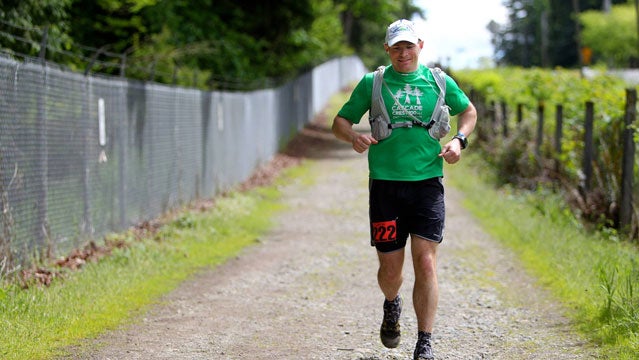We’ve been eager to thoroughly test DeLorme’s new handheld, the first affordable satellite device to send and receive text messages on its own screen and keyboard. You can do this anywhere on the globe, using the Iridium satellite network, which has a larger footprint than the GlobalStar network used by rival (also called Spot2).
So when we received the review unit, we asked ultramarathoner Gavin Woody to try out its functions in one of his typical single-track excursions in the deep backcountry. Woody took first place in Pigtails Challenge 150 Mile in May, second place in the in June, and finished in the top half of the prestigious last summer. He’s also president of , the 107-year-old, 10,000-person climbing organization in Seattle.
Would he trade in his much-loved Spot2 which works in conjunction with his iPhone for a single device? Woody took the inReach SE on an 18-mile training run up Thorpe Mountain near Cle Elum, Washington (just east of Snoqualmie pass.) His route took him up 4,000 feet of elevation, with a few stops to email back and forth to his wife, text, and post to Facebook.
Here’s his verdict:
“Everything worked well, although typing on the keypad was painfully slow. The two-way texting feature was great (my wife liked being able to proactively reach me on a trip if necessary), and in posting to Facebook, I was able to get confirmation of delivery. I liked the “track” feature, which left a every 10 minutes.
“While running up Thorpe, I put the device on top of my backpack with the antenna toward the sky. I was planning to do a loop rather than an out-and-back, but when I found out there was way too much snow, I decided to turn around. I sent a message about this, but it failed to send at first, so I moved to an alternate location and it finally sent. It was nice to have the message delivery confirmation.
“The device is bit bulkier than my Spot2, but not absurdly so [at 5.9 inches tall and 6.7 ounces, the inReach SE is around 2 inches taller and 1.5 ounces heavier than the Spot2]. I also question the non-removable rechargeable battery in the new version. For full weekend excursions, I like to carry extra disposables for my devices. However, on an expedition where you’d be carrying a solar charger, I can see how this would make sense.
“I’m not sure how the inReach would work in my trips. I bucket adventures into risk categories of low, medium, and high. For a low-risk, short-term run, I’ll take my phone and hope for enough coverage that I could call 911 if I sprained an ankle and had to drag myself down a mountain. For a day-long trek in the backcountry, I’d take my phone and either this inReach or a SPOT. But if I’m climbing in a remote area over a number of days, I feel better taking a Personal Locator Beacon (PLB), which sends out two signals—satellite as well as a terrestrial homing beacon for rescuers.
“For example, when I climbed Rainier’s Liberty Ridge in early June, my partner and I each carried separate devices—one of us had a Spot2 to send “OK” and “We’re running late” messages to our wives, and the other had a McMurdo PLB. That way, if one of us fell in a crevasse (or worse), the other would still have a communication device.
“Will I move from the Spot to the SE? Two-way texting is nice, but if I really wanted this capability, I would probably go with the inReach model that’s been on the market, the “inReach Smartphone,” and pair that with my iPhone. The color screen and on-screen keyboard on the updated version just don’t make that much of a difference to me.”
$299.95 (requires network plan starting at $10 per month)


